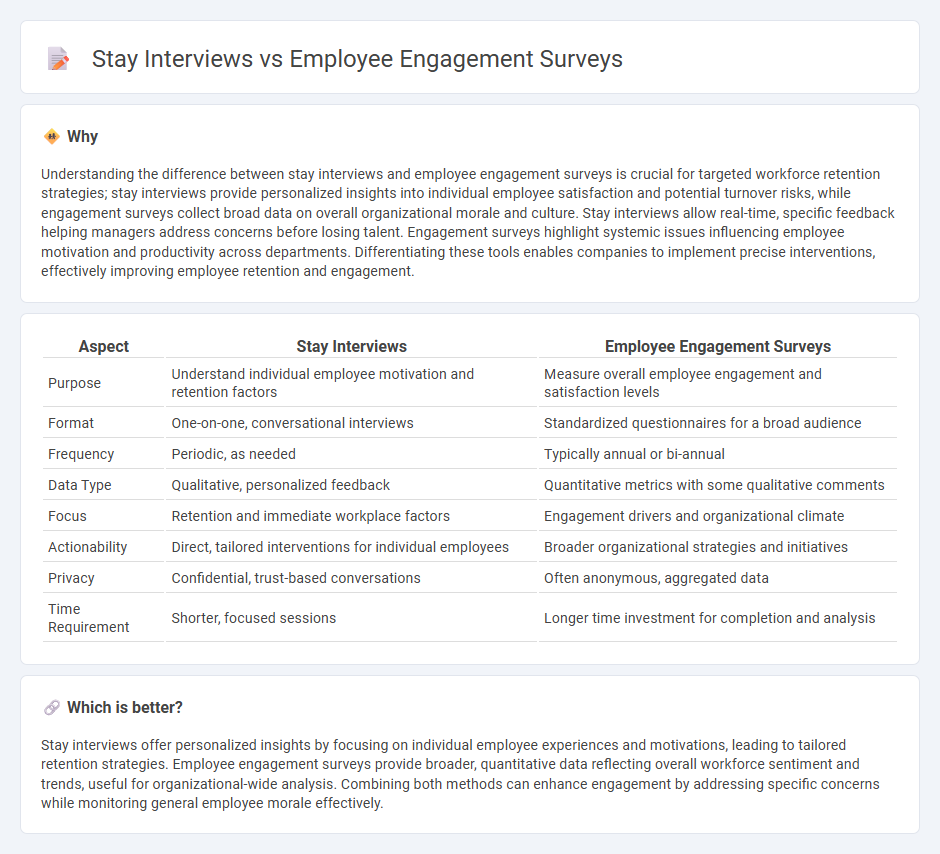
Stay interviews provide personalized insights by directly engaging employees in conversations about their job satisfaction and workplace needs, allowing organizations to address issues proactively. Employee engagement surveys collect broader data on overall employee morale, motivation, and organizational commitment but may lack the depth of individualized feedback. Discover how combining both approaches can enhance retention and create a more motivated workforce.
Why it is important
Understanding the difference between stay interviews and employee engagement surveys is crucial for targeted workforce retention strategies; stay interviews provide personalized insights into individual employee satisfaction and potential turnover risks, while engagement surveys collect broad data on overall organizational morale and culture. Stay interviews allow real-time, specific feedback helping managers address concerns before losing talent. Engagement surveys highlight systemic issues influencing employee motivation and productivity across departments. Differentiating these tools enables companies to implement precise interventions, effectively improving employee retention and engagement.
Comparison Table
| Aspect | Stay Interviews | Employee Engagement Surveys |
|---|---|---|
| Purpose | Understand individual employee motivation and retention factors | Measure overall employee engagement and satisfaction levels |
| Format | One-on-one, conversational interviews | Standardized questionnaires for a broad audience |
| Frequency | Periodic, as needed | Typically annual or bi-annual |
| Data Type | Qualitative, personalized feedback | Quantitative metrics with some qualitative comments |
| Focus | Retention and immediate workplace factors | Engagement drivers and organizational climate |
| Actionability | Direct, tailored interventions for individual employees | Broader organizational strategies and initiatives |
| Privacy | Confidential, trust-based conversations | Often anonymous, aggregated data |
| Time Requirement | Shorter, focused sessions | Longer time investment for completion and analysis |
Which is better?
Stay interviews offer personalized insights by focusing on individual employee experiences and motivations, leading to tailored retention strategies. Employee engagement surveys provide broader, quantitative data reflecting overall workforce sentiment and trends, useful for organizational-wide analysis. Combining both methods can enhance engagement by addressing specific concerns while monitoring general employee morale effectively.
Connection
Stay interviews provide real-time insights into employee satisfaction and potential concerns, complementing employee engagement surveys that gather broader data on workplace morale and motivation. Both tools focus on understanding employee needs, improving retention rates, and fostering a positive organizational culture. Combining qualitative feedback from stay interviews with quantitative survey results enables more targeted strategies for enhancing engagement and reducing turnover.
Key Terms
Feedback
Employee engagement surveys collect broad feedback across an organization, measuring overall satisfaction and identifying trends, while stay interviews provide personalized, real-time insights into individual employee motivations and concerns. Surveys often use quantitative data to assess engagement levels, whereas stay interviews enable qualitative dialogue that can uncover specific factors influencing retention. Explore how combining these feedback tools can enhance workforce engagement and retention strategies further.
Retention
Employee engagement surveys provide broad insights into workplace satisfaction and organizational culture, capturing trends that impact overall retention rates. Stay interviews offer personalized feedback, targeting individual employee motivations and potential retention risks by addressing specific concerns in real-time. Explore detailed strategies to leverage both tools effectively for improving workforce stability and reducing turnover.
Communication
Employee engagement surveys provide quantitative data on communication effectiveness across the organization, revealing trends and areas for improvement through standardized questions. Stay interviews offer personalized, qualitative insights by allowing managers to discuss communication preferences and challenges directly with employees in real-time. Explore how combining these methods can create a comprehensive communication strategy to boost employee satisfaction and retention.
Source and External Links
Employee Engagement Surveys: Ultimate Guide - SurveyMonkey - This guide explains how employee engagement surveys can detect dissatisfaction, improve company culture, and includes the employee Net Promoter Score (eNPS) to measure overall satisfaction and engagement with a simple key question.
45 Proven Employee Engagement Survey Questions - Details different types of employee engagement surveys such as annual, pulse, and employee lifecycle surveys, highlighting their unique roles in measuring and improving employee engagement.
Employee Engagement Surveys: The Questions to Ask & Why - Offers practical tips, templates, and sample questions to create effective surveys that capture employee sentiment across key areas like job satisfaction, workload, and manager relationships.
 dowidth.com
dowidth.com